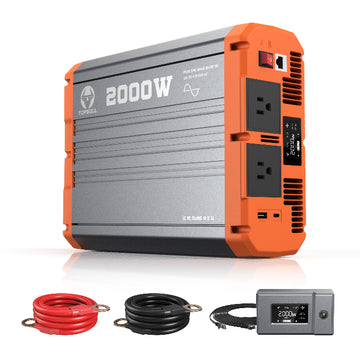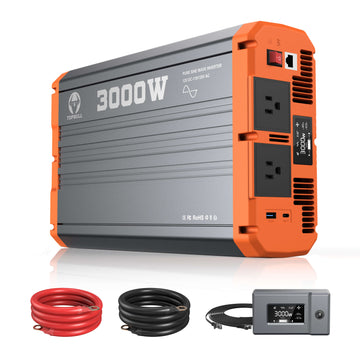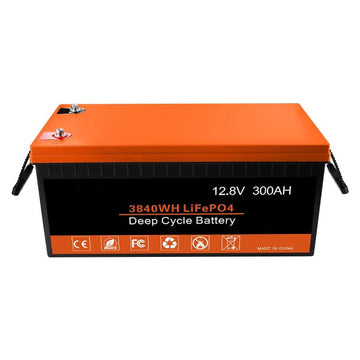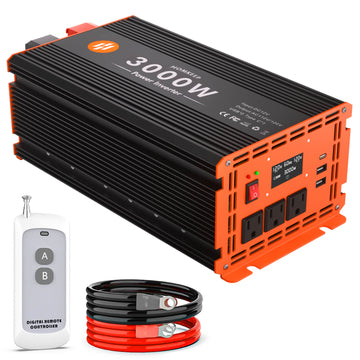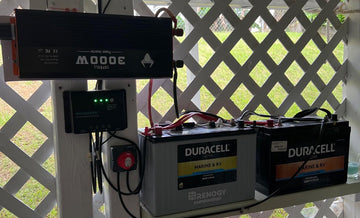Whether working remotely, traveling in an RV, planning off-grid setups, or managing energy use at home, understanding how many watts a laptop uses is more than just a tech curiosity; it is a practical necessity. To make it simple, for most models, the average falls between 30 and 70 watts, though this varies based on the laptop's size, performance level, and how it's being used. Lightweight ultrabooks and idle machines might draw as little as 15 watts, while gaming rigs can spike well over 100 watts during heavy tasks.
But wattage isn't just about power bills, but it also determines whether your inverter or battery backup can handle your laptop, especially when you're off the grid or on the go. In this guide, we'll break down everything you need to know, from daily consumption to inverter compatibility, so you can stay powered up wherever you work or play.
Related Reading:
How Many Watts Does a Coffee Maker Use: Answers & Tips
How to Install a Power Inverter in an RV [Step by Step]
Laptop Wattage Breakdown: What Affects Power Usage?
Now that we've established the typical power range for laptops, let's dive deeper into the factors that affect power consumption. From your laptop's model to the way you use it daily, and even whether it's charging, each of these elements plays a role in how much electricity it draws. Below is a detailed breakdown by usage scenario and laptop category to help you understand your laptop's energy profile.
Wattage by Laptop Type
| Laptop Type | Typical Wattage Range | When Plugged In / Charging |
| Business Laptop |
45–75W
|
Up to 90W (including charger draw) |
| Ultrabook / Thin Laptop |
30–60W
|
Up to 65W |
| MacBook (e.g., 15") |
60–87W
|
85–100W with original charger |
|
Gaming Laptop
|
100–180W | Up to 230W under full load |
Wattage by Activity
-
Idle or Low Activity (e.g., documents, browsing): 15–30 watts
-
Standard Office Work: 30–60 watts
-
Streaming & Online Meetings: 40–70 watts
-
Gaming / Heavy Software (e.g., video editing): 100–180+ watts
-
Charging Only: 30–100+ watts, depending on battery level
- Standby or Sleep Mode: 1–5 watts
Note: Laptop chargers usually range from 45W to 230W, which reflects their maximum output, not the constant draw during regular use.
Wattage by Time
Your computer's power usage also depends on how long you use it each day. If your laptop averages 60W and runs for 5 hours daily, then:
-
In 24 hours: 60W × 5h = 300 Wh, or 0.3 kWh per day
- In a month: 0.3 kWh/day × 30 = 9 kWh per month
For context, that's relatively low, making laptops one of the most energy-efficient computing options, especially compared to desktops.
How to Measure Your Laptop's Power Use Accurately
If you want to know exactly how many watts your laptop computer uses, estimates alone won't cut it. Here's how to measure real-time laptop power consumption accurately and reliably:
Check the Power Adapter Label
The easiest starting point is your laptop's power brick. Look for a label that shows output wattage (e.g., 65W, 87W, or 120W). This tells you the maximum power the adapter can supply—not necessarily what your laptop is always drawing, but it gives you a rough ceiling.
Use a Plug-in Power Meter
Devices like Kill A Watt or other plug-in watt meters let you monitor real-time power draw by plugging your laptop charger into the meter and then into a wall outlet. This shows actual usage in watts while your laptop is idle, charging, or under heavy load.
Monitor via System Tools
You can also get insights using built-in or third-party software tools:
-
Windows: Tools like HWMonitor, Open Hardware Monitor, or BatteryInfoView can show approximate power draw.
- macOS: Use the Activity Monitor (Energy tab) or check "System Report > Power" for battery stats.
- Linux: Commands like "powertop" and "upower" offer detailed consumption data and tuning tips.
By combining these methods, you can get a comprehensive picture of how much power your laptop uses during different activities, which helps save energy or size the right inverter for off-grid setups.
Can You Use a Laptop with a Power Inverter?
Yes, you can run an inverter for your laptop, but only if you're using the right kind of inverter. Whether you're traveling in an RV, working out of your car, or relying on a backup power system during an outage, a power inverter can help keep your laptop running. But compatibility and safety are key.
Why Inverter Specs Matter
Laptops are relatively low-wattage devices, typically needing 30–100W, but that doesn't mean any inverter will do. You should:
- ✅ Use an inverter with pure sine wave output for clean, stable electricity—especially important for sensitive electronics like laptops.
- ✅ Make sure the inverter supports the wattage of your charger, plus some buffer. A 200W inverter is generally sufficient for one laptop, but more devices = higher demand.
What Happens If You Use the Wrong Inverter?
Using a modified sine wave inverter or an underpowered unit can result in:
- 🔌 Charger overheating or malfunctioning
- ⚠️ Shortened battery life or damage to the laptop
- 🔥 In some cases, tripping the inverter's fuse or damaging internal components
If you run multiple electronics or work from your vehicle often, it's smart to invest in a high-quality pure sine wave inverter, like the ones from Topbull, to ensure safety and performance.
Best Inverter for Running a Laptop: Topbull Picks
If you're planning to power your laptop off-grid, whether from a car, RV, solar setup, or during an outage, choosing the right pure sine wave inverter makes all the difference. When it comes to powering laptops off-grid, Topbull's pure sine wave inverters are purpose-built to deliver clean, reliable electricity without compromise. Here's why Topbull is a top choice.
-
Pure Sine Wave Output: Provides stable, utility-grade power—essential for laptops, chargers, and sensitive electronics like monitors and networking gear. Avoids noise, overheating, and long-term damage.
-
Advanced Safety Protection: Includes safeguards for overload, over-temperature, short circuit, low/high voltage, and more, keeping both your devices and the inverter secure during operation.
-
Optimized for Mobile & Off-Grid Use: Whether you're working in an RV, camping off the grid, or need backup power during outages, Topbull delivers dependable performance with quiet fans and a compact design.
-
Efficient & High-Capacity Power Conversion: Designed with high conversion efficiency and fast response to load changes, ensuring smooth transitions and reliable output even for power-hungry laptops or gaming rigs.
- Versatile Ports & Easy Setup: Multiple AC outlets, USB charging ports, and a remote control interface (on select models) make setup and daily use simple and flexible.
With Topbull's advanced features in mind, the next step is choosing the right inverter model for your setup. Whether you're powering a lightweight business laptop or a high-performance gaming machine, Topbull inverter matches your energy needs both at home and on the move. Here's how to find your ideal fit.
| Use Case | Recommended Model | Why It's a Good Fit |
| Basic off-grid use | Topbull 2000W Pure Sine Wave Inverter | Ideal for charging a single laptop, phone, or small electronics while traveling light. |
| Remote work with multiple devices | Topbull 3000W Pure Sine Wave Inverter | Power laptops, monitors, and office gear simultaneously—great for van life professionals. |
| Full RV or solar setups | Topbull 4000W Pure Sine Wave Inverter | Supports high-wattage needs, including laptops, fridges, and coffee makers in one system. |
No matter your setup, Topbull provides the best inverter solution for running a laptop safely and efficiently anywhere, anytime.
Final Words
Understanding how many watts your laptop uses isn't just about saving energy; it's essential for anyone working off-grid, using solar setups, or preparing for power outages. Whether you're commuting, camping, or coping with blackouts, reliable power matters. Topbull's pure sine wave inverters deliver clean, stable electricity with built-in protection for your devices. No matter your lifestyle, there's a model that fits your needs. Stay powered. Work anywhere with the right inverter from Topbull.

